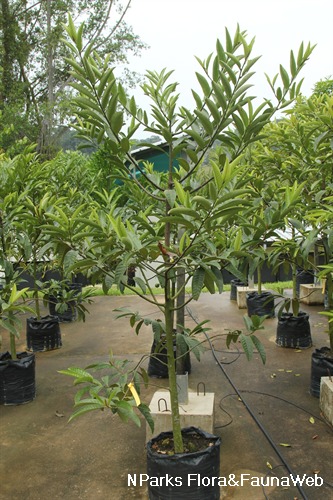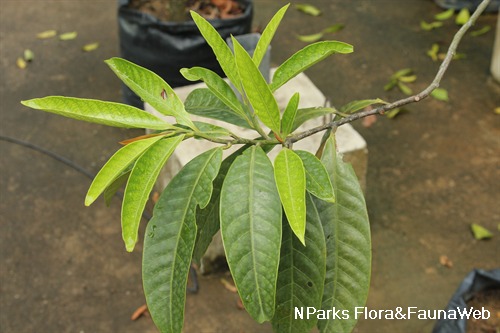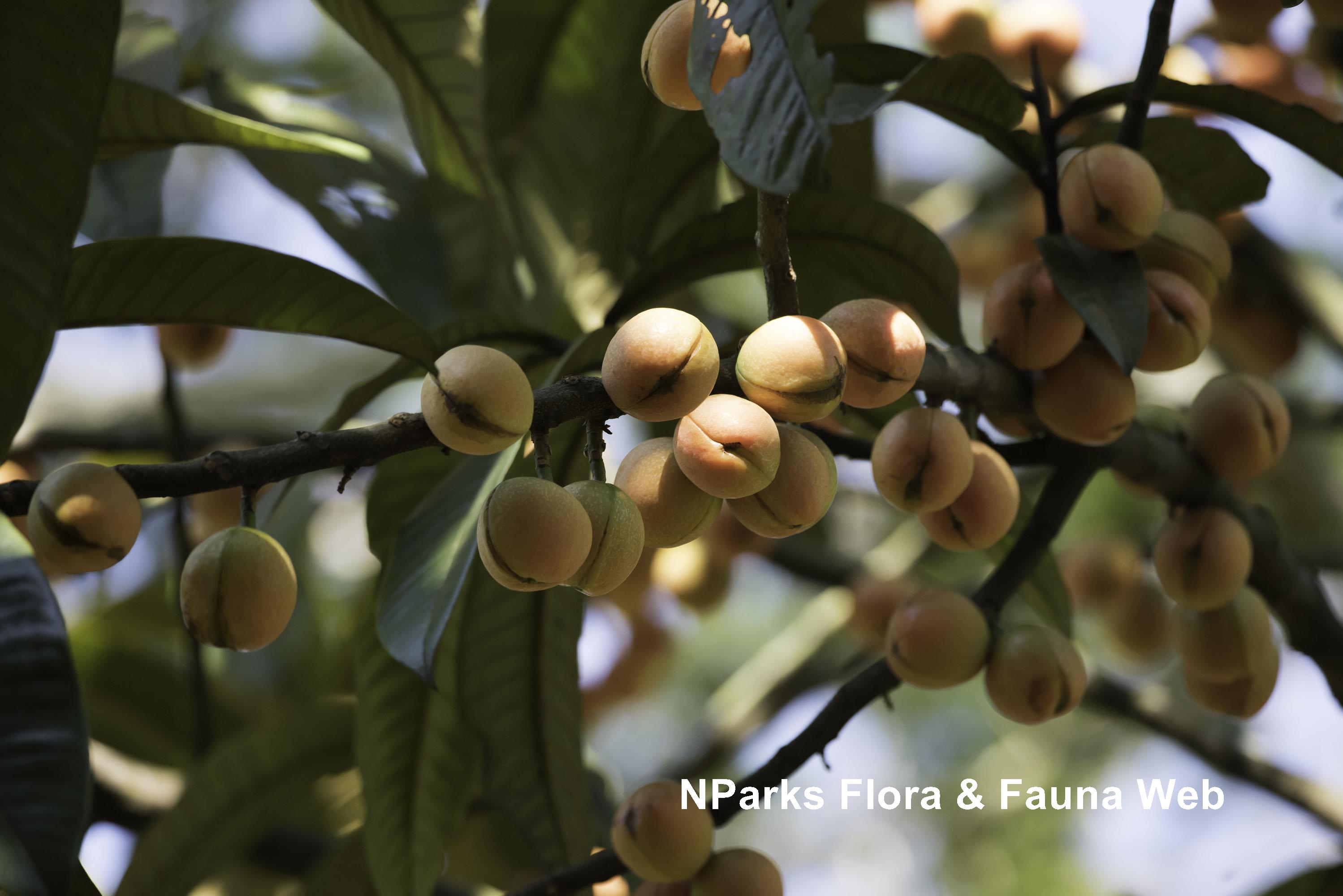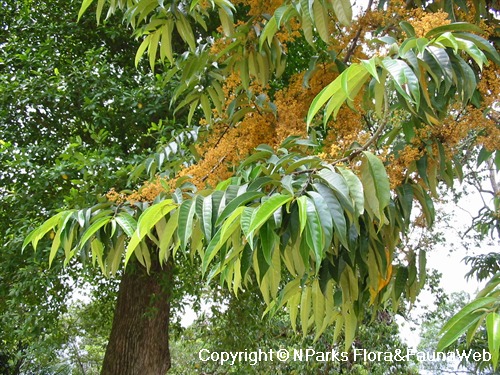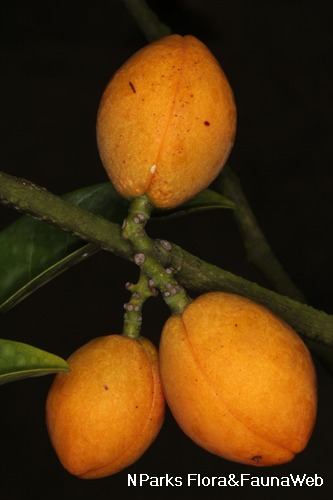
Back
Horsfieldia crassifolia (Hook.f. & Thomson) Warb.
| Family Name: | Myristicaceae |
| Synonyms: | Myristica crassifolia Hook.f. & Thomson |
Name
Classifications and Characteristics
| Plant Division | Angiosperms (Flowering Seed Plants) (Dicotyledon) |
|---|---|
| Plant Growth Form | Tree |
| Lifespan (in Singapore) | Perennial |
| Mode of Nutrition | Autotrophic |
| Plant Shape | Irregular |
| Maximum Height | 25 m |
Biogeography
| Native Distribution | Southern Thailand, Sumatra, Peninsular Malaysia, Singapore and Borneo |
|---|---|
| Native Habitat | Terrestrial (Primary Rainforest, Freshwater Swamp Forest) |
| Preferred Climate Zone | Tropical |
| Local Conservation Status | Native to Singapore (Critically Endangered (CR)) |
Description and Ethnobotany
| Growth Form | It is a tree up to 25 m tall. |
|---|---|
| Foliage | Its alternate, stalked leaves possess leathery leaf blades that are oval to oblong, green above, rusty or cinnamon-brown below, and 10–28 by 3.5–10 cm. Its leaves’ undersides are also covered with hairs that are 0.1 mm long, or turn hairless with age to show distinct hair scars, and scattered dark dots and dashes. |
| Flowers | The species is dioecious as each individual produces only male or female flowers. Its flowers are in flowering shoots (inflorescences) that have hairs of 0.2–0.5 mm long. Its male flowering shoots are branched clusters of flowers, and are 6–20 by 4–15 cm. Its female flowering shoots are 3–14 cm long. Its flowers are yellow, and its male flowers are smaller than its female flowers. |
| Fruit | Its fruiting clusters (infructescences) contain 1–10 fruits each. Its fruits are egg-shaped to drop-shaped, hairless, and 1.5–2.5 by 1.2–1.8 cm. The fruit wall is 1.5–2 mm thick. Its seed is egg-shaped, and has a orange, fleshy covering (aril). |
| Habitat | It grows in marshy forests, freshwater and peatswamp forests, up to 200 m altitude. |
| Associated Fauna | Its flowers are insect-pollinated. The seeds are covered with an orange aril which are eaten by hornbills and mammals. |
| Cultivation | It can be cultivated by seed. |
| Etymology | Horsfieldia, named after Dr. Thomas Horsfield (1773–1859), an American botanist who explored in the Malesian islands; Latin crassus, thick; Latin folium, means leaf, referring to the species’ thick leaf blades. |
Landscaping Features
| Landscaping | It can be grown along roadsides and in parks for its attractive inflorescences and orange coloured fruits. It can also be planted as a food source to attract hornbills. |
|---|---|
| Desirable Plant Features | Ornamental Flowers, Ornamental Fruits |
| Landscape Uses | General, Suitable for Roadsides, Parks & Gardens, Small Gardens, Riverine |
| Thematic Landscaping | Naturalistic Garden |
Fauna, Pollination and Dispersal
| Fauna Pollination Dispersal Associated Fauna | Bird-Attracting (Fruits, Associated with: Anthracoceros albirostris, Buceros rhinoceros) |
|---|---|
| Pollination Method(s) | Biotic (Fauna) |
| Seed or Spore Dispersal | Biotic (Fauna) (Vertebrates (Other Mammal)) |
Plant Care and Propagation
| Light Preference | Full Sun |
|---|---|
| Water Preference | Moderate Water |
| Plant Growth Rate | Moderate |
| Rootzone Tolerance | Moist Soils, Fertile Loamy Soils |
| Propagation Method | Seed |
Foliar
| Foliage Retention | Evergreen |
|---|---|
| Mature Foliage Colour(s) | Green |
| Mature Foliage Texture(s) | Leathery |
| Foliar Type | Simple / Unifoliate |
| Foliar Arrangement Along Stem | Alternate |
| Foliar Attachment to Stem | Petiolate |
| Foliar Shape(s) | Non-Palm Foliage (Oval, Oblong) |
| Foliar Venation | Pinnate / Net |
| Foliar Margin | Entire |
| Leaf Area Index (LAI) for Green Plot Ratio | 3.0 (Tree - Intermediate Canopy) |
Floral (Angiosperm)
| Flower & Plant Sexuality | Unisexual Flowers , Dioecious |
| Flower Colour(s) | Yellow / Golden |
|---|
| Flower Grouping | Cluster / Inflorescence |
| Flower Location | Axillary |
| Flower Symmetry | Radial |
Fruit, Seed and Spore
| Mature Fruit Colour(s) | Orange |
|---|---|
| Fruit Classification | Simple Fruit |
| Fruit Type | Dehiscent Dry Fruit , Capsule |
Image Repository
Others
| Master ID | 1670 |
|---|---|
| Species ID | 2963 |
| Flora Disclaimer | The information in this website has been compiled from reliable sources, such as reference works on medicinal plants. It is not a substitute for medical advice or treatment and NParks does not purport to provide any medical advice. Readers should always consult his/her physician before using or consuming a plant for medicinal purposes. |

